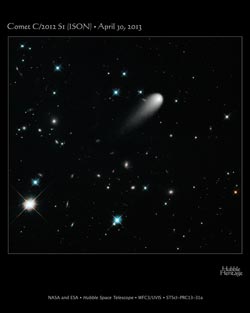NASA’s Hubble: Galaxies, Comets, and Stars! Oh My!

<br>
In reality, the comet is much, much closer. The nearest star to the sun is over 60,000 times farther away, and the nearest large galaxy to the Milky Way is over thirty billion times more distant.
These vast dimensions are lost in this deep space Hubble exposure that visually combines our view of the universe from the very nearby to the extraordinarily far away.
In this composite image, background stars and galaxies were separately photographed in red and yellow-green light. Because the comet moved between exposures relative to the background objects, its appearance was blurred. The blurred comet photo was replaced with a single, black-and-white exposure. The images were taken with the Wide Field Camera 3 on April 30, 2013.
The Hubble Space Telescope is a project of international cooperation between NASA and the European Space Agency. NASA's Goddard Space Flight Center in Greenbelt, Md., manages the telescope. The Space Telescope Science Institute
(STScI) in Baltimore, Md., conducts Hubble science operations. STScI is operated by the Association of Universities for Research in Astronomy Inc., in Washington, D.C.
For image files and more information about Comet ISON, visit:
http://hubblesite.org/news/2013/31
http://heritage.stsci.edu/2013/31
For more information about the Hubble Space Telescope, visit:
http://www.nasa.gov/hubble
Image Credit: NASA, ESA, and the Hubble Heritage Team (STScI/AURA)
Text Credit: Ray Villard, Space Telescope Science Institute, Baltimore, Md.
Media Contact
All latest news from the category: Physics and Astronomy
This area deals with the fundamental laws and building blocks of nature and how they interact, the properties and the behavior of matter, and research into space and time and their structures.
innovations-report provides in-depth reports and articles on subjects such as astrophysics, laser technologies, nuclear, quantum, particle and solid-state physics, nanotechnologies, planetary research and findings (Mars, Venus) and developments related to the Hubble Telescope.
Newest articles

Bringing bio-inspired robots to life
Nebraska researcher Eric Markvicka gets NSF CAREER Award to pursue manufacture of novel materials for soft robotics and stretchable electronics. Engineers are increasingly eager to develop robots that mimic the…

Bella moths use poison to attract mates
Scientists are closer to finding out how. Pyrrolizidine alkaloids are as bitter and toxic as they are hard to pronounce. They’re produced by several different types of plants and are…

AI tool creates ‘synthetic’ images of cells
…for enhanced microscopy analysis. Observing individual cells through microscopes can reveal a range of important cell biological phenomena that frequently play a role in human diseases, but the process of…





















